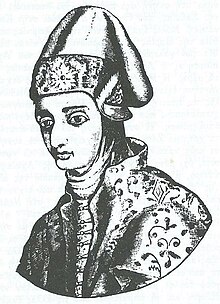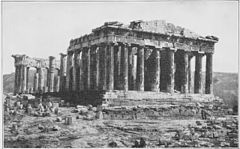Nerio I. Acciaiuoli
Nerio I. Acciaiuoli (full name Rainerio , also Neri ; * 1st half of the 14th century in Florence (?); † November 25, 1394 in Athens ) came from the important Florentine banking family of the Acciaiuoli , who were regular in the 14th century money to the Anjou - monarch of Naples lent. From 1360 Nerio was the deputy of his influential relative Niccolò Acciaioli in Franconian Greece. He bought large areas in the Principality of Achaia and administered them independently of the absent princes. In 1374 or 1375 he captured Megara , a strategically important fortress in the Duchy of Athens . From 1388 he was the 1st Duke of Athens in the Acciaiuoli family.
Life
Nerio was a son of Jacopo Acciaiuoli and Bartolomea Ricasoli and was the brother of Donato Acciaiuoli of Cassano , Giovanni Acciaiuoli, Latin Archbishop of Patras and Angelo Acciauoli , Bishop and Cardinal of the Roman Church .
prehistory

The Anjou needed the support of the Acciaiuoli banking family in the financial management of their property in Franconian Greece. In 1331 the Acciaiuoli set up their first bank branch in the economic and urban center of the Franconian principality of Achaia, Glarentza.
Jacobo Acciaiuoli's second cousin, Niccolò Acciaioli, was from 1335 as an advisor to the widowed titular empress of Constantinople , Catherine de Valois-Courtenay (d. 1346) and tutor of her three sons in the service of King Robert of Anjou . Among the children of Catherinea was the new prince of Achaia, Robert of Taranto . Niccolò built up his property in Morea through donations and purchases; mainly in Elis , Arcadia and around Kalamata in Messenia . Between October 1338 and June 1341 Catherine de Valois-Courtenay and her retinue were in Morea. Robert of Taranto did not return to Morea, but left a number of regents as his representatives. Niccolò then devoted himself to the affairs of the Neapolitan kingdom . In April 1358 he received the rule of Corinth .
Baron von Vostitza and Nivelot
Since the children of Niccolòs Acciaiuoli showed little interest in their father's Greek possessions, the latter adopted his extended relative Nerio I Acciaiuoli in 1362. After the death of his adoptive father (November 8, 1365) he received the baronies of Vostitza and Nivelot in Greece.
In 1366 Nerio deposed the governor of Corinth Angelo Acciaiuoli (Niccolò's son) and replaced him with his brother Donato. In 1371 Nerio found a way to expand his domain by having the city of Corinth delivered to him by Angelo, the son of Niccolò, as a pledge of a loan and made his brother Donato lord of Corinth. The Burgvogtei of Corinth was made a hereditary palatinate for Nerio on February 27, 1371 in Brindisi and four years later all his titles and possessions in Greece were given to Joan I of Anjou , Queen of Naples (1343-1382) and Princess of Achaia (1373-1381), confirmed.
In November 1372 Nerio, as Lord of Corinth, received the circular from Pope Gregory XI. addressed to the Emperor of Constantinople and the Lords of Greece on the 13th of the month . Past Gregory XI. called them to a crusade against the Ottomans .
Conquests
Nerio took advantage of the conflicts between the Veguians of Thebes and Athens in the Duchy of Athens in 1374/1375 to besiege Megara from the Catalans and conquer it. Megara was never retaken from the Catalans and controlled the isthmus to Athens and Thebes.
At the end of 1376 or beginning of 1377 Johanna I of Anjou leased her principality Achaia (the Franconian Morea) for five years and 4000 ducats per year to the Crusaders of the Order of St. John . In June 1378, the Johanniter hired the Navarre Company , a group of mercenaries from Navarre in Spain and Gascony in southern France .
In the 1380s Nerio devoted himself to the fight against the Navarre Company and the Ottomans in Argolis , a landscape on the Greek peninsula of Peloponnese .
On April 31, 1381, the Spanish Peter IV of Aragon , Duke of Athens and Neopatria , announced the arrival of the royal deputy, Philip Dalman, in Athens. Together with the royal deputy, Nerio defended Athens from the Ottomans in 1384, whereupon the Aragonese king sent him a letter of congratulations to continue the collaboration with the Catalans that had begun so fruitfully. Apparently the anti-Ottoman alliance with the Catalans was supported by the Venetian Republic . Nerio soon turned to other friendships, however.
Shortly thereafter, Nerio, who appeared to have approached the Ottomans, revealed his plans and attacked the Catalans. In 1385 Nerio marched into the Duchy of Athens with a mercenary army and described himself as the Lord of the Duchy.
Thebes, which had been conquered in 1379 and Livadia in Boeotia in 1380/81 by the Navarre company under Juan de Urtubia, seems to have fallen to him in 1388, since he and his family were described as living there during the siege of Athens. In 1388 Nerio also wrested Platea , Thebes , Megara and Sikyon from the Catalans .
Between April 1387 and May 1388, Nerio besieged and conquered the Acropolis , whose occupation surrendered on May 2, 1388, ending the Catalan rule in Greece that had lasted since 1311. Nerio called himself henceforth "Lord of Corinth and the Duchy".
Duke of Athens
In 1388 Nerio attempted to strengthen his position in Greece through a number of important marriages. His eldest daughter, Bartolomea, became the wife of Theodor I Palaiologos , despot of Morea and enemy of the Catalans. His other daughter, Francesca, was married to Carlo I Tocco , Duke of Lefkada and Count Palatine of Kefalonia and Zakynthos . Neither of them seems to have provided material aid in their campaigns to Attica , but at least their non-interference was assured. Nerio fought against both the Catalans and the Navarrese during his conquest of the duchy and was imprisoned by the Navarrese in Patras for almost a year in 1389/90 . In 1390 Neopatras in Thessaly was handed over to Nerio, who lost the duchy to the Ottoman Sultan Bayezid I in January 1394 .
Nerio died in Athens on November 25, 1394. According to his will of September 17, 1394, Nerio divided his property and lands among his children. He gave Corinth, Megara and Vasilika to his younger daughter Francesca. He left Livadia, Thebes and Boeotia to his biological son Antonio and placed the Duchy of Athens under the protection of Venice. His eldest daughter Bartolomea, who was considered the most beautiful woman of her time and was married to Theodorus I Palaiologos, was paid 9700 ducats (which her husband had borrowed from Nerio). When Carlo I Tocco owned Corinth for a short time, he was forced the executor to sign a document stating that they had only followed the will of the testator. Apparently Nerio had preferred his daughter Francesca to Bartolomea.
Family and offspring
Before 1381 Nerio married Agnese Saraceno, daughter of Saraceno Saraceni from Negroponte who had no male offspring. Nerio endeavored to secure his power through an active marriage policy.
- Bartolomea Acciaiuoli († around 1397) ⚭ 1388 Theodoros I. Palaiologos , depot of Morea and enemy of the Catalans (no children of the couple are known)
- Francesca Acciaiuoli († after 1430), regent of the Duchy of Athens from 1394 to 1395; In 1430 she handed over the dominions she had inherited from her father to her half-brother Antonio from ⚭ 1388 Carlo I. Tocco , Count Palatine of Kefalonia (without descendants)
- Antonio I. Acciaiuoli († early 1435 in Athens suffering from apoplexy ; illegitimate son with his Greek mistress Maria Rendi, daughter of the notary Demetrius Rendi of Athens), received Livadia, Thebes and Boeotia from his father; In 1402 conquered Athens, which his father had given to the Church of the Virgin Mary Venice and which had been occupied by the Venice; on March 31, 1405, Antonio recognized the patronage of Venice over the Duchy of Athens and was recognized by the Serenissima as the legitimate Duke of Athens; from 1430 lord of Megara and Sikyon; In 1406 he temporarily occupied Staria and in 1423 Corinth; ⚭ Maria Melissene, daughter of Leone Melissenos and Elena Calcondila, from a noble Greek family from the Peloponnese . She tried to follow her husband, but was defeated in 1435 and banished from Athens.
literature
- John Van Antwerp Fine: A Critical Survey from the Late Twelfth Century to the Ottoman Conquest . University of Michigan Press, 1994, ISBN 0-472-08260-4 ( preview in Google Book Search).
- Ferdinand Gregorovius : History of the City of Athens in the Middle Ages. From the time of Justinian to the Turkish conquest. 2 volumes. Cotta, Stuttgart 1889, ( digitized volume 1 , digitized volume 2 ; numerous editions).
- Peter Lock: The Franks in the Aegean, 1204-1500 . Taylor & Francis , 1995, ISBN 0-582-05140-1 ( preview in Google Book Search).
- Armando Petrucci: Acciaiuoli, Neri. In: Alberto M. Ghisalberti (Ed.): Dizionario Biografico degli Italiani (DBI). Volume 1: Aaron – Albertucci. Istituto della Enciclopedia Italiana, Rome 1960, pp. 85-86.
- Steven Runciman : The Lost Capital of Byzantium. The History of Mistra and the Peloponnese . Harvard University Press, 1980, ISBN 978-0-674-03405-1 .
- Kenneth Meyer Setton, Harry Williams Hazard: A History of the Crusades. Vol. 3: The Fourteenth and Fifteenth Centuries . University of Wisconsin Press, 1975, ISBN 0-299-06670-3 ( preview in Google Book Search).
- Davide Shamà: I di Tocco, Sovrani dell'Epiro e di Leucade. Studio storico-genealogico . In: Notiario dell'Associazione Nobiliare Regionale Veneta, anno V, n.5 . La Musa Talìa, Venice 2013, p. 45–118 (here 1–74) .
- Jonathan Simon Christopher Riley-Smith: The crusades: a history . Continuum, London 2005, ISBN 0-8264-7269-9 ( preview in Google Book Search).
Web links
- Acciaoli, Duchi di Atene, Conti di Melfi e Linee Patrizie e Marchionali Fiorentine. Genmarenostrum.com, accessed August 16, 2020 .
Individual evidence
- ↑ Peter Lock, The Franks in the Aegean, 1204-1500. Taylor & Francis, 1995, p. 129
- ↑ Peter Lock, The Franks in the Aegean, 1204-1500. Taylor & Francis, 1995, p. 10
- ↑ a b c Peter Lock, The Franks in the Aegean, 1204-1500. Taylor & Francis, 1995, p. 130
- ^ A b c Armando Petrucci: Acciaiuoli, Neri. In: Alberto M. Ghisalberti (Ed.): Dizionario Biografico degli Italiani (DBI). Volume 1: Aaron – Albertucci. Istituto della Enciclopedia Italiana, Rome 1960, pp. 85-86.
- ↑ a b c d e f Peter Lock, The Franks in the Aegean, 1204–1500. Taylor & Francis, 1995, p. 131
- ↑ Kenneth Meyer Setton, Harry Williams Hazard: A History of the Crusades. Vol. 3: The Fourteenth and Fifteenth Centuries, p. 211
- ^ John Van Antwerp Fine: A Critical Survey from the Late Twelfth Century to the Ottoman Conquest. University of Michigan Press, p. 401
- ↑ Kenneth Meyer Setton, Harry Williams Hazard: A History of the Crusades. Vol. 3: The Fourteenth and Fifteenth Centuries, p. 218
- ↑ a b c d Acciaoli, Duchi di Atene, Conti di Melfi e Linee Patrizie e Marchionali Fiorentine in: Genmarenostrum.com
- ↑ a b Davide Shamà, I di Tocco, Sovrani dell'Epiro e di Leucade, p. 15
- ↑ Steven Runciman: The Lost Capital of Byzantium. The History of Mistra and the Peloponnese, Harvard University Press, 1980, p. 57
| predecessor | Office | successor |
|---|---|---|
|
Peter of Aragón (King Peter IV of Aragon) |
Duke of Athens 1388-1394 |
Antonio I. Acciaiuoli and Francesca Acciaiuoli |
| personal data | |
|---|---|
| SURNAME | Nerio I. Acciaiuoli |
| ALTERNATIVE NAMES | Neri, Raineri |
| BRIEF DESCRIPTION | Duke of Athens |
| DATE OF BIRTH | 14th Century |
| DATE OF DEATH | November 25, 1394 |
| Place of death | Athens |







